Collaborative Optimization Scheduling of Resilience and Economic Oriented Islanded Integrated Energy System under Low Carbon Transition
Abstract
:1. Introduction
- (1)
- Aiming at the difference between IES device configuration and actual operation, this paper proposes a two-layer optimization strategy model and innovatively extends the IES configuration and optimization strategy by using the BGRU model and the IALO algorithm to predict the outgoing power and to reduce the time consuming to solve the problem;
- (2)
- In this paper, the Markov decision-making process is applied to the IES energy supply chain to make full use of the energy storage so as to further optimize the reliability and economy of the IES energy supply in an integrated manner;
- (3)
- Depending on how much resilience and economic goals are valued, combined with the parameterization of the forbearing stratified sequencing method, it is possible to adjust the goals that the IES configuration runs want to achieve.
2. Modeling
2.1. Integrated Energy System Model
2.2. Objective Function
2.3. Binding
3. Methodology
3.1. IES Mdp
3.2. Forbearing Stratified Sequencing Method
3.3. Improved Ant Lion Algorithm
3.4. Bidirectional Gated Recurrent Unit
3.5. Resilient Economy Two-Layer Optimization Strategy
4. Examples and Results
4.1. Prediction Model Analysis
4.2. Algorithm Function Performance Test
4.3. Configuration Results
4.4. Operation Analysis
5. Conclusions
- (1)
- The use of a two-layer optimization strategy can provide timely feedback to convey resilience and economic metrics, accelerate the solution of the resilience-economy multi-objective problem using the tolerance hierarchical sequence method and the IALO algorithm, and arrive at an optimal solution for the optimization of the IES configuration and operation in multiple iterations;
- (2)
- During the typical day operation phase, using the Markov reward decision-making process can make decisions that are most compatible with the loss of load and economic cost multi-objective planning to further optimize the reliability and economics of the IES supply capacity in a comprehensive manner;
- (3)
- The method proposed in this paper can be combined with the parameter setting of the tolerance of the forbearing stratified sequencing method and the selection of priority objectives to adjust the resilience and economic cost objectives that the IES decision maker wants to achieve.
Author Contributions
Funding
Institutional Review Board Statement
Informed Consent Statement
Data Availability Statement
Conflicts of Interest
References
- Wang, J.; Zheng, X.; Tai, N.; Wei, W.; Li, L. Resilience-Oriented Optimal Operation Strategy of Active Distribution Network. Energies 2019, 12, 3380. [Google Scholar] [CrossRef]
- Kabeyi, B.; Olanrewaju, A. Sustainable Energy Transition for Renewable and Low Carbon Grid Electricity Generation and Supply. Front. Energy Res. 2022, 9, 1032. [Google Scholar] [CrossRef]
- Ren, H.; Jiang, Z.; Wu, Q.; Li, Q.; Yang, Y. Integrated optimization of a regional integrated energy system with thermal energy storage considering both resilience and reliability. Energy 2022, 261, 125333. [Google Scholar] [CrossRef]
- Pan, X.; Shen, Z.; Song, M.; Shu, Y. Enhancing green technology innovation through enterprise environmental governance: A life cycle perspective with moderator analysis of dynamic innovation capability. Energy Policy 2023, 182, 113773. [Google Scholar] [CrossRef]
- He, M.; Wang, Y.; Ma, H. Ecological effect life cycle assessment of house buildings based on emergy footprint model. Sci. Rep. 2023, 13, 16441. [Google Scholar] [CrossRef] [PubMed]
- Mehleri, E.D.; Sarimveis, H.; Markatos, N.C.; Papageorgiou, L.G. A mathematical programming approach for optimal design of distributed energy systems at the neighbourhood level. Energy 2012, 44, 96–104. [Google Scholar] [CrossRef]
- Zafeiropoulou, M.; Mentis, I.; Sijakovic, N.; Terzic, A.; Fotis, G.; Maris, T.I.; Vita, V.; Zoulias, E.; Ristic, V.; Ekonomou, L. Forecasting Transmission and Distribution System Flexibility Needs for Severe Weather Condition Resilience and Outage Management. Appl. Sci. 2022, 12, 7334. [Google Scholar] [CrossRef]
- Adewumi, O.B.; Fotis, G.; Vita, V.; Nankoo, D.; Ekonomou, L. The Impact of Distributed Energy Storage on Distribution and Transmission Networks’ Power Quality. Appl. Sci. 2022, 12, 6466. [Google Scholar] [CrossRef]
- Cadini, F.; Agliardi, G.L.; Zio, E. A modeling and simulation framework for the reliability/availability assessment of a power transmission grid subject to cascading failures under extreme weather conditions. Appl. Energy 2017, 185, 267–279. [Google Scholar] [CrossRef]
- Li, X.; Sun, T.; Hou, K. Evaluating Resilience of Island Integrated Energy Systems with Earthquake. Proc. CSEE 2020, 40, 17. [Google Scholar]
- Watson, P.L.; Spaulding, A.; Koukoula, M.; Anagnostou, E. Improved quantitative prediction of power outages caused by extreme weather events. Weather Clim. Extrem. 2022, 37, 100487. [Google Scholar] [CrossRef]
- Azad, S.; Ghandehari, M. A Study on the Association of Socioeconomic and Physical Cofactors Contributing to Power Restoration After Hurricane Maria. IEEE Access 2021, 9, 98654–98664. [Google Scholar] [CrossRef]
- Chen, Y.; Xu, F.; Zhang, W. Research on standby configuration and retention criteria for energy security in new power systems. J. Power Syst. Autom. 2022, 34, 32–40. [Google Scholar] [CrossRef]
- Liu, J.Y.; Shen, B.; Zhou, J. A resilient urban distribution network restoration approach taking into account critical load function restoration requirements. Electric Power Constr. 2022, 43, 66–75. [Google Scholar]
- Lv, C.; Yu, H.; Li, P. Coordinated operation and planning of integrated electricity and gas community energy system with enhanced operational resilience. IEEE Access 2020, 8, 59257–59277. [Google Scholar] [CrossRef]
- Liu, T.; Zhu, Y.; Sun, R. Resilience enhanced strategy for cyber-physical power system under extreme natural disasters. Autom. Electr. Power Syst. 2021, 45, 40–48. [Google Scholar]
- Jia, B.; Li, D.; Li, X. Two-stage restorationstrategy for multi fault of an electric gas integrated energy system. Power Syst. Prot. Control 2022, 50, 113–123. [Google Scholar]
- Ye, H.; Wang, J.; Ge, Y.; Li, J.; Li, Z. Robust integration of high-level dispatchable renewables in power system operation. IEEE Trans. Sustain. Energy 2017, 8, 826–835. [Google Scholar] [CrossRef]
- Huang, G.B.; Zhu, Q.Y.; Siew, C.K. Extreme Learning Machine: Theory and Application. Neurocomputing 2006, 70, 489–501. [Google Scholar] [CrossRef]
- Zhang, J.; Zhang, Z. Short-Term photovoltaic system power forecasting based on PSO-BP neural network. Renew. Energy Resour. 2012, 30, 28–32. [Google Scholar]
- Farah, S.; Aneela, Z.; Muhammad, M. A novel genetic LSTM model for wind power forecast. Energy 2021, 223, 120069. [Google Scholar]
- Zhang, P.; Li, C.; Peng, C.; Tian, J. Ultra-Short-Term Prediction of Wind Power Based on Error Following Forget Gate-Based Long Short-TermMemory. Energies 2020, 13, 5400. [Google Scholar] [CrossRef]
- Shaikh, A.K.; Nazir, A.; Khan, I.; Shah, A.S. Short term energy consumption forecasting using neural basis expansion analysis for interpretable time series. Sci. Rep. 2022, 12, 22562. [Google Scholar] [CrossRef]
- Cheng, W.; Li, J.; Xiao, H.C.; Ji, L.N. Combination predicting model of traffic congestion index in weekdays based on LightGBM-GRU. Sci. Rep. 2022, 12, 2912. [Google Scholar] [CrossRef] [PubMed]
- Sajjad, M.; Khan, Z.A.; Ullah, A.; Hussain, T.; Ullah, W.; Lee, M.Y.; Baik, S.W. A Novel CNN-GRU-Based Hybrid Approach for Short-Term Residential Load Forecasting. IEEE Access 2020, 8, 143759–143768. [Google Scholar] [CrossRef]
- Xiaoqiao, H.; Qiong, L.; Yonghang, T.; Zaiqing, C.; Jun, L.; Junsheng, S.; Wuming, L. Time series forecasting for hourly photovoltaic power using conditional generative adversarial network and Bi-LSTM. Energy 2022, 246, 123403. [Google Scholar]
- Xiong, J.; Peng, T.; Tao, Z.; Zhang, C.; Song, S.; Nazir, M.S. A dual-scale deep learning model based on ELM-BiLSTM and improved reptile search algorithm for wind power prediction. Energy 2023, 266, 126419. [Google Scholar] [CrossRef]
- Zajac, S.; Huber, S. Objectives and methods in multi-objective routing problems: A survey and classification scheme. Eur. J. Oper. Res. 2021, 290, 1–25. [Google Scholar] [CrossRef]
- Zeng, Z.; Fang, Y.P.; Zhai, Q.; Du, S. A Markov reward process-based framework for resilience analysis of multistate energy systems under the threat of extreme events. Reliab. Eng. Syst. Saf. 2021, 209, 107443. [Google Scholar] [CrossRef]
- Duan, Y.; Zhao, Y.; Hu, J. An initialization-free distributed algorithm for dynamic economic dispatch problems in microgrid: Modeling, optimization and analysis. Sustain. Energy Grids Netw. 2023, 34, 101004. [Google Scholar] [CrossRef]
- Zhang, M.; Hu, Z.; Wag, X. Two stage stochastic programming scheduling model based on dynamic scenario sets and demand response. Autom. Electr. Power Syst. 2017, 41, 68–76. [Google Scholar]

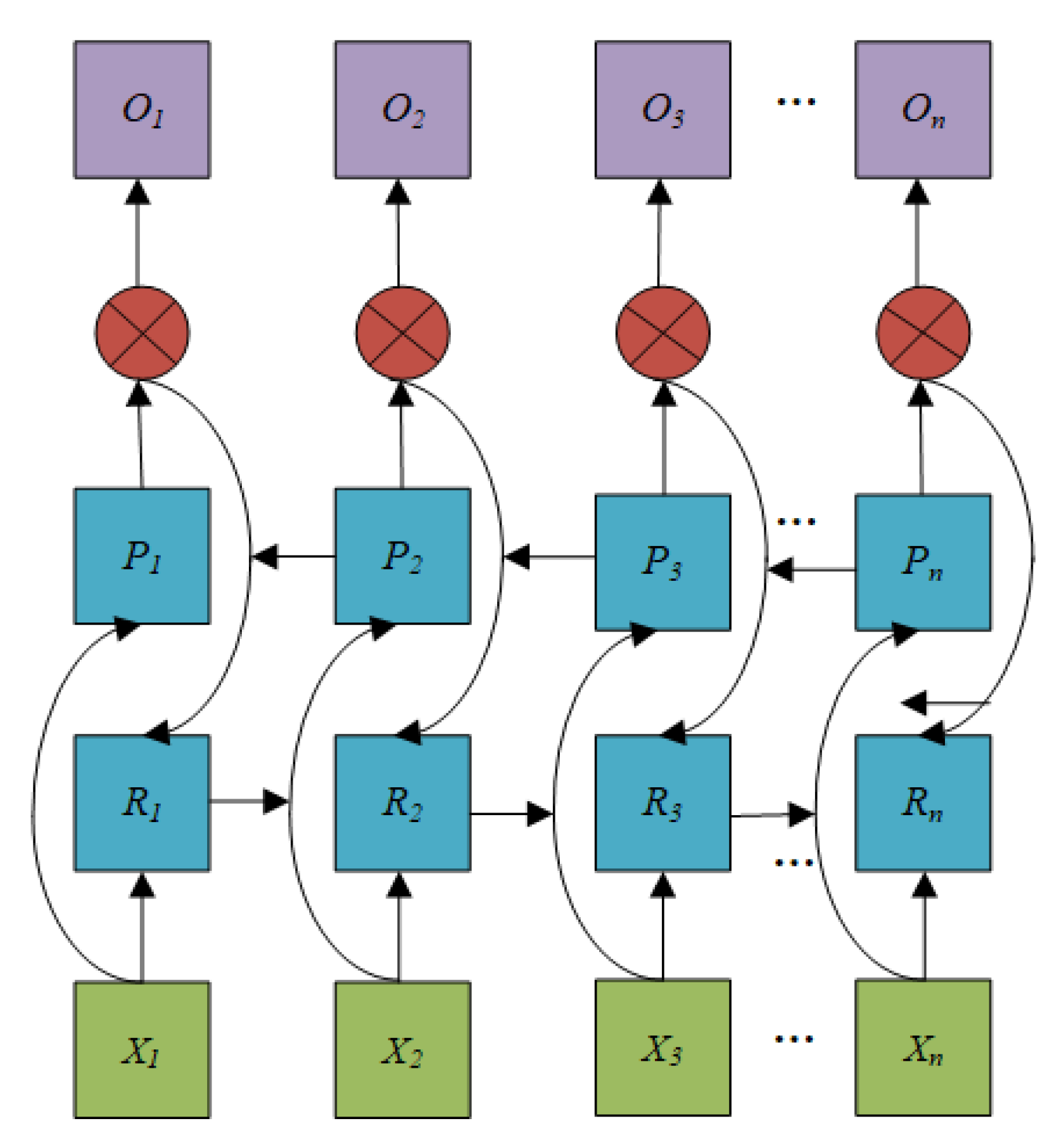
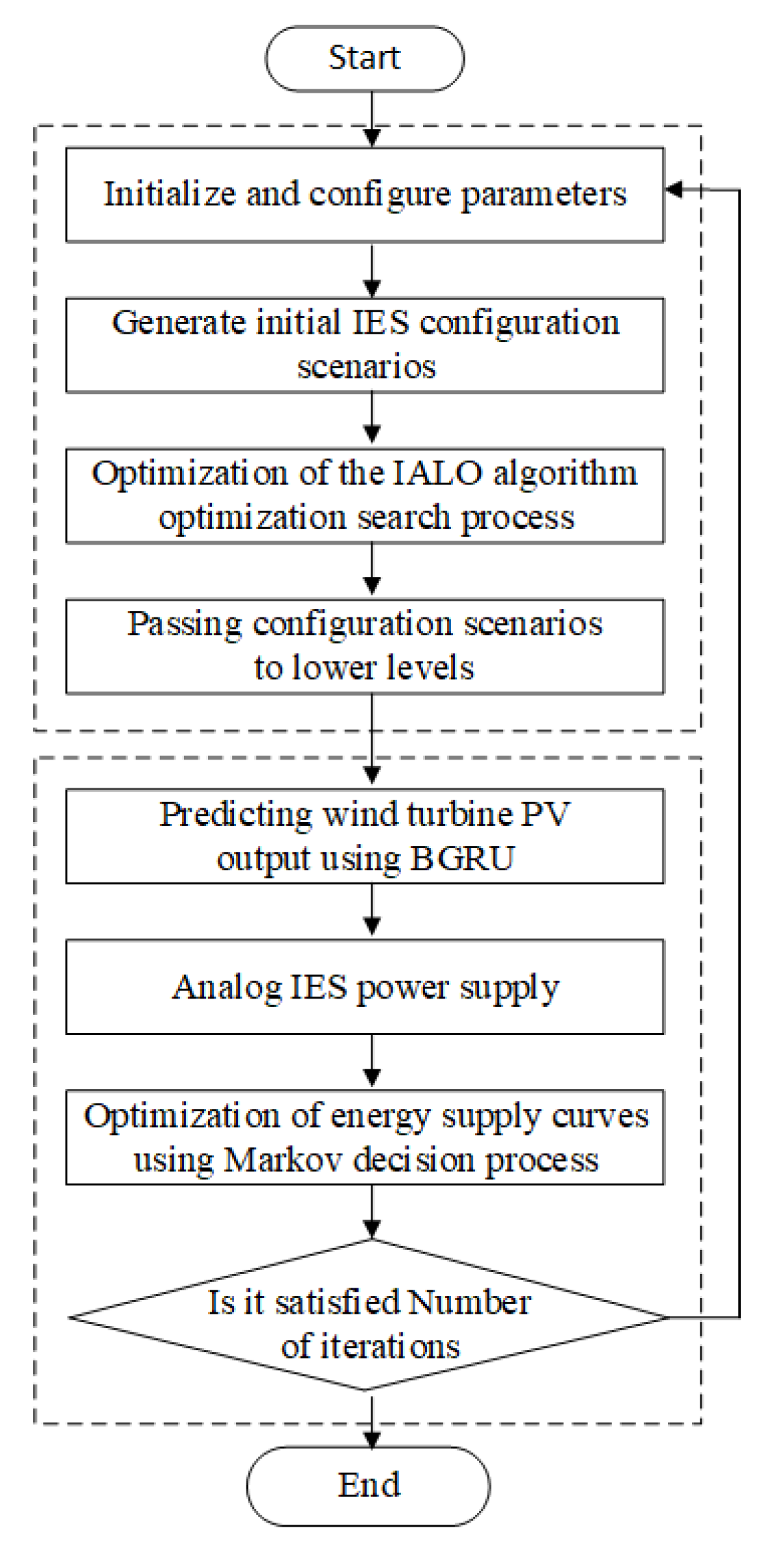
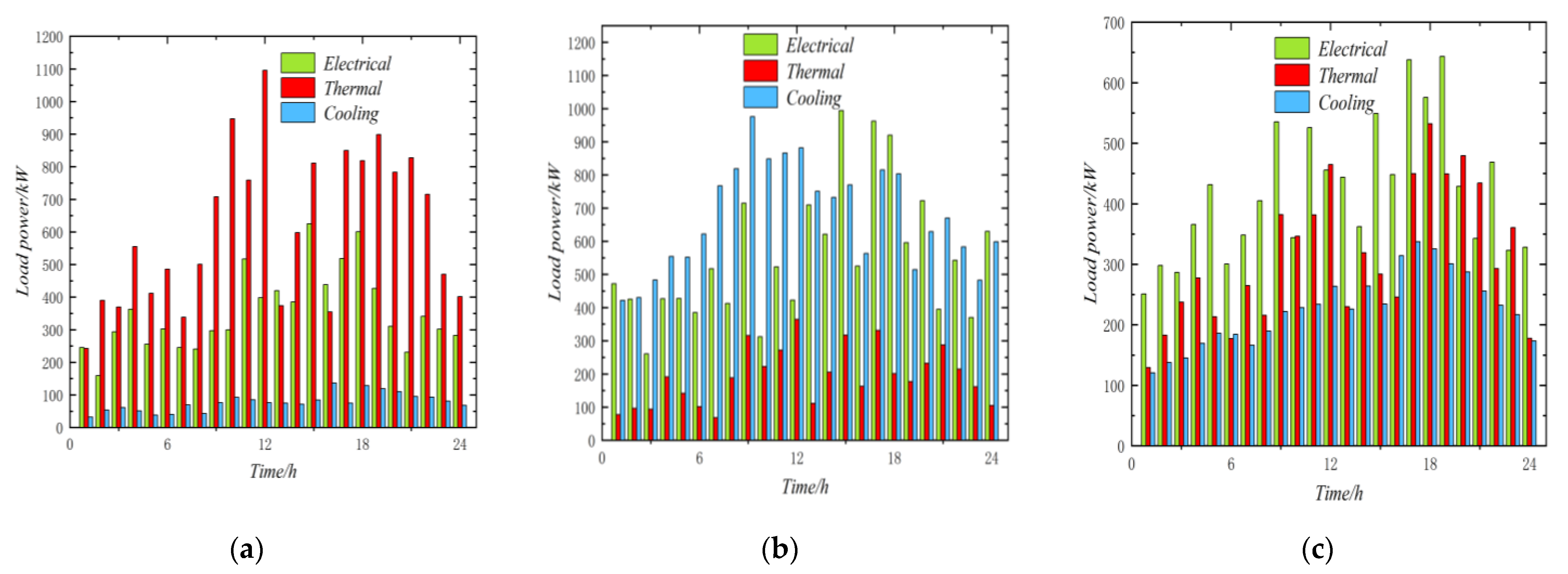

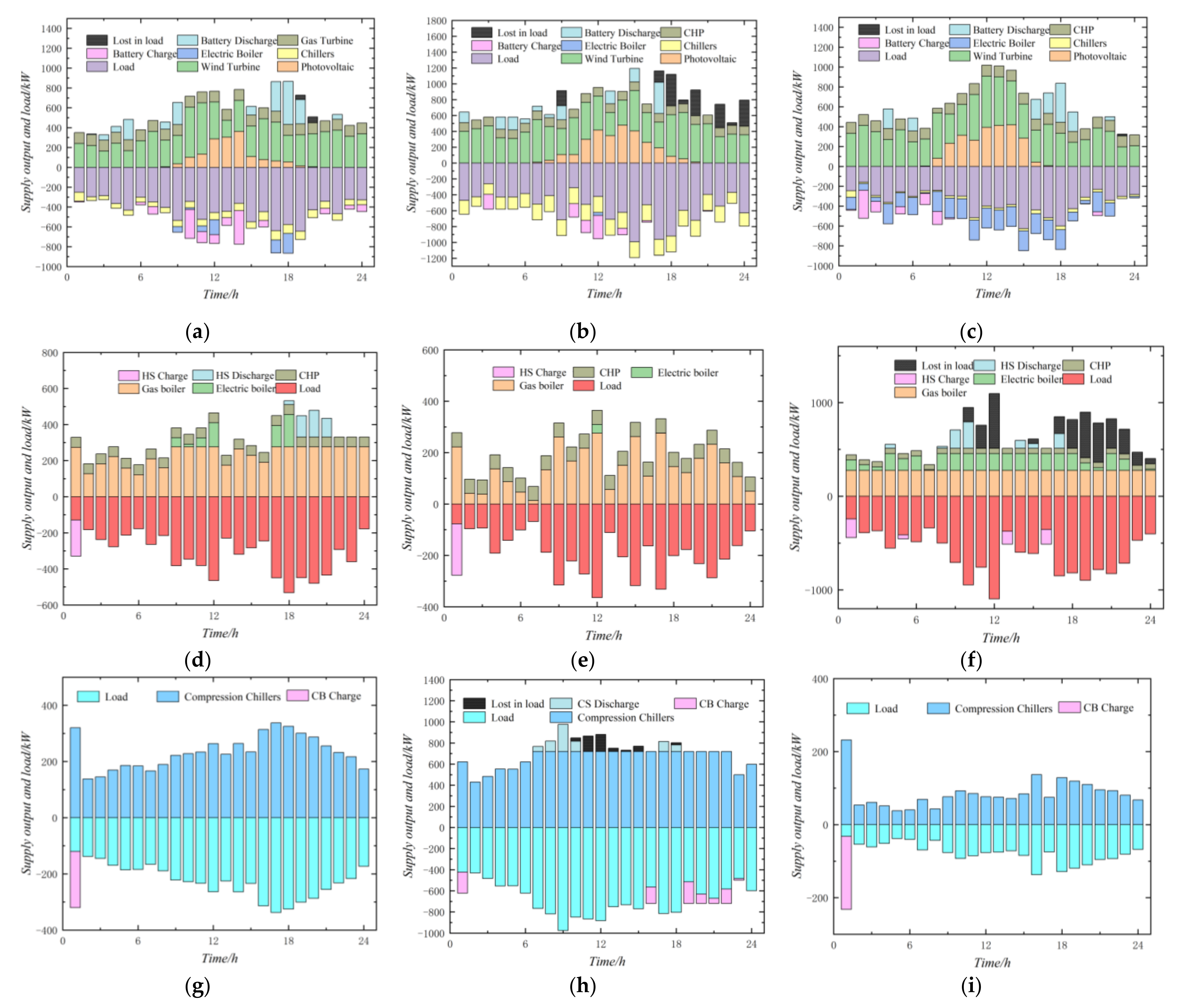
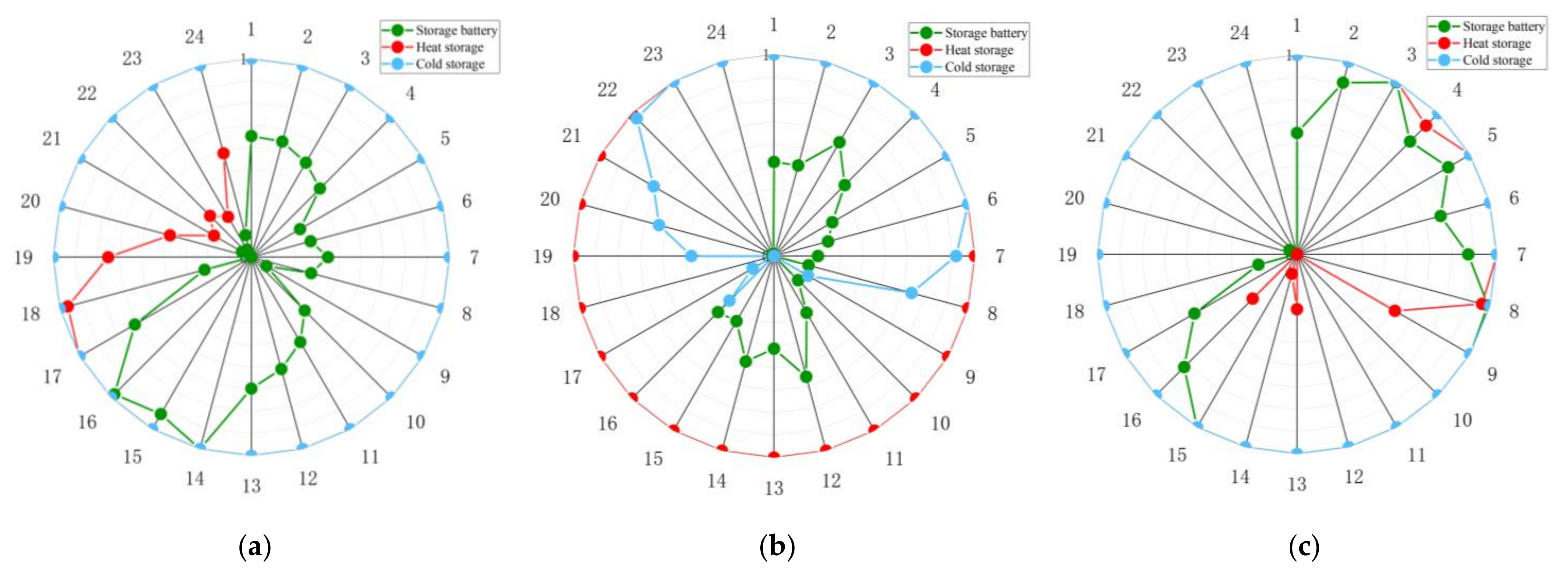
| Sets and Symbols | Abbreviations | Sets and Symbols | Abbreviations |
|---|---|---|---|
| t | Index of time periods | q | Start-stop state and output value of each unit |
| s | Index of simulation runs of IES counting example | h | Equation constraint |
| v | Index of equipment | g | Inequality constraint |
| ¯, _ | Max and min value of parameters | Q | Optimal operating strategy of IES |
| CO | Random coefficient generated by the Cauchy distribution function | ||
| Parameters | Abbreviations | Parameters | Abbreviations |
| ηCHPe | Conversion efficiency of gas-to-electricity of the CHP unit | μv | Unit price of investment in the equipment v |
| ηCHPh | Conversion efficiency of gas-to-thermal of the CHP unit | yv | Useful life of the equipment v |
| λg | Calorific value of consumed natural gas | COMv | Operation and maintenance coefficients for the equipment v |
| ηGB | Gas turbine’s power generation efficiency | CECv | Energy consumption coefficients for the equipment v |
| ηEB | Electric transfer efficiency of the electric boiler | Iv | Corresponding maximum installed capacity of device v |
| ηCC | Conversion efficiency of the compression refrigerator from electricity to cold | Imax | Upper limit of the size capacity of the IES |
| χj, χk, χl | Index of load levels in the electricity, and heating and cooling networks | γ | Markov reward decision process discount factor |
| rv | Discount rate of the equipment v | ||
| Variables | Abbreviations | Variables | Abbreviations |
| PCHPt | Generation power of the CHP unitat time t | R | Resilience index of the IES |
| GCHPt | Amount of natural gas consumed by the CHP unit at time t | Rw | Corresponding weighted reward value for IES |
| PWTt | Actual output of the wind turbine | Δest | Load loss of the electricity |
| uWTt | Installed capacity of the wind turbine | Δhst | Load loss of the heat |
| PPVt | Actual output of the photovoltaic | Δcst | Load loss of the cooling |
| uPVt | Installed capacity of the photovoltaic | LEt | Baseline loads of the electricity |
| Pvt | Output power of the energy supply equipment v at time t | LHt | Baseline loads of the heat |
| HCHPt | Heating power supplied by the CHP unit at time t | LCt | Baseline loads of the cooling |
| HGBt | Amount of heat supplied by the gas boiler at time t | Mij | Initial position |
| HEBt | Thermal power of the electric boiler at time t | M’ij | Next updated position of the initial position |
| EEBt | Electrical power consumed by the electric boiler at time t | x0, y0 | Original positions of the ant lion |
| CCCt | Refrigeration power of the compression refrigerator at time t | x’0, y’0 | New positions of ant lion |
| ECCt | Electric power consumed by the compressor at time t | η | Constant controlling the variation step |
| PSBDt | Storage battery discharge power at time t | C | Total economic cost of the IES |
| PSBCt | Storage battery charge power at time t | Ci | Investment cost of energy supply equipment |
| PHSDt | Heat storage tank discharge power at time t | Co | Operation and maintenance cost of the IES |
| PHSCt | Heat storage tank charge power at t | Cc | Energy consumption costs |
| PCSDt | Cold storage tank discharge power at time t | nv | Number of units of the type of equipment v |
| PCSCt | Cold storage tank charge power at time t | ε | Tolerance |
| SSBt | Charging state of the storage battery | SHSt | Charging state of the heat storage tank |
| SCSt | Charging state of the cold storage tank |
| Indicators | MAE | MAPE | RMSE | Indicators |
|---|---|---|---|---|
| SVR | 44.81 | 11.93% | 68.78 | SVR |
| LSTM | 32.66 | 8.96% | 44.20 | LSTM |
| GRU | 34.09 | 9.43% | 41.21 | GRU |
| BGRU | 30.61 | 9.03% | 39.82 | BGRU |
| IPSO | SSA | ALO | IALO | |
|---|---|---|---|---|
| f1 | 1.599 × 10−1238.6 | 0.085 | 1.4117 × 10−6 | 0 |
| f2 | 13.582 | 17.753 | 8.750 | 9.351 × 10−11 |
| f3 | −0.914 | −1.131 | −1.032 | −1.032 |
| Equipment | Number of Equipment | |||
|---|---|---|---|---|
| Scenario I | Scenario 2 | Scenario 3 | Scenario 4&5 | |
| Gas turbine | 6 | 6 | 4 | 3 |
| Gas boiler | 5 | 4 | 3 | 3 |
| Chillers | 1 | 1 | 1 | 1 |
| Photovoltaic | 2 | 4 | 3 | 5 |
| Wind turbine | 6 | 5 | 5 | 3 |
| Electric boiler | 0 | 1 | 1 | 2 |
| Heat storage tank | 0 | 1 | 1 | 1 |
| Cold storage tank | 0 | 0 | 0 | 1 |
| Storage battery | 1 | 1 | 2 | 2 |
| Scenario | Costs/Thousand ¥ | |||
|---|---|---|---|---|
| C | CI | CO | CC | |
| Scenario 1 | 688.19 | 473.69 | 137.98 | 76.52 |
| Scenario 2 | 739.55 | 494.92 | 154.54 | 90.09 |
| Scenario 3 | 782.37 | 495.61 | 169.95 | 116.81 |
| Scenario 4 | 817.06 | 532.46 | 178.72 | 105.88 |
| Scenario 5 | 862.27 | 532.46 | 205.30 | 124.51 |
| Scenario | R | ||
|---|---|---|---|
| Spring and Fall | Summer | Winter | |
| Scenario 1 | 0.853 | 0.823 | 0.679 |
| Scenario 2 | 0.880 | 0.803 | 0.731 |
| Scenario 3 | 0.897 | 0.806 | 0.835 |
| Scenario 4 | 0.996 | 0.939 | 0.886 |
| Scenario 5 | 0.928 | 0.873 | 0.784 |
| Time | Spring and Fall | Summer | Winter | ||||||
|---|---|---|---|---|---|---|---|---|---|
| Electric | Heat | Cold | Electric | Heat | Cold | Electric | Heat | Cold | |
| 1 | 0.00 | 0.00 | 0.00 | 0.00 | 0.00 | 0.00 | 0.00 | 0.00 | 0.00 |
| 2 | 0.00 | 0.00 | 0.00 | 0.00 | 0.00 | 0.00 | 0.00 | 0.00 | 0.00 |
| 3 | 0.00 | 0.00 | 0.00 | 0.00 | 0.00 | 0.00 | 0.00 | 0.00 | 0.00 |
| 4 | 0.00 | 0.00 | 0.00 | 0.00 | 0.00 | 0.00 | 0.00 | 0.00 | 0.00 |
| 5 | 0.00 | 0.00 | 0.00 | 0.00 | 0.00 | 0.00 | 0.00 | 0.00 | 0.00 |
| 6 | 0.00 | 0.00 | 0.00 | 0.00 | 0.00 | 0.00 | 0.00 | 0.00 | 0.00 |
| 7 | 0.00 | 0.00 | 0.00 | 0.00 | 0.00 | 0.00 | 0.00 | 0.00 | 0.00 |
| 8 | 0.00 | 0.00 | 0.00 | 0.00 | 0.00 | 0.00 | 0.00 | 0.00 | 0.00 |
| 9 | 0.00 | 0.00 | 0.00 | 190.98 | 0.00 | 0.00 | 0.00 | 0.00 | 0.00 |
| 10 | 0.00 | 0.00 | 0.00 | 0.00 | 0.00 | 30.52 | 0.00 | 153.43 | 0.00 |
| 11 | 0.00 | 0.00 | 0.00 | 0.00 | 0.00 | 146.06 | 0.00 | 247.51 | 0.00 |
| 12 | 0.00 | 0.00 | 0.00 | 0.00 | 0.00 | 161.58 | 0.00 | 584.50 | 0.00 |
| 13 | 0.00 | 0.00 | 0.00 | 0.00 | 0.00 | 30.92 | 0.00 | 0.00 | 0.00 |
| 14 | 0.00 | 0.00 | 0.00 | 0.00 | 0.00 | 12.11 | 0.00 | 0.00 | 0.00 |
| 15 | 0.00 | 0.00 | 0.00 | 0.00 | 0.00 | 49.60 | 0.00 | 49.76 | 0.00 |
| 16 | 0.00 | 0.00 | 0.00 | 0.00 | 0.00 | 0.00 | 0.00 | 0.00 | 0.00 |
| 17 | 0.00 | 0.00 | 0.00 | 144.04 | 0.00 | 0.00 | 0.00 | 182.06 | 0.00 |
| 18 | 0.00 | 0.00 | 0.00 | 398.75 | 0.00 | 21.64 | 0.00 | 307.74 | 0.00 |
| 19 | 44.22 | 0.00 | 0.00 | 48.03 | 0.00 | 0.00 | 0.00 | 487.36 | 0.00 |
| 20 | 59.75 | 0.00 | 0.00 | 326.21 | 0.00 | 0.00 | 0.00 | 422.12 | 0.00 |
| 21 | 0.00 | 0.00 | 0.00 | 0.00 | 0.00 | 0.00 | 0.00 | 316.00 | 0.00 |
| 22 | 0.00 | 0.00 | 0.00 | 298.92 | 0.00 | 0.00 | 0.00 | 264.44 | 0.00 |
| 23 | 0.00 | 0.00 | 0.00 | 33.38 | 0.00 | 0.00 | 0.00 | 139.15 | 0.00 |
| 24 | 0.00 | 0.00 | 0.00 | 329.83 | 0.00 | 0.00 | 0.00 | 56.79 | 0.00 |
| Total | 103.97 | 0.00 | 0.00 | 1770.13 | 0.00 | 452.43 | 0.00 | 3210.87 | 0.00 |
| Time | Spring and Fall | Summer | Winter | ||||||
|---|---|---|---|---|---|---|---|---|---|
| SB | HS | CS | SB | HS | CS | SB | HS | CS | |
| 1 | 0.61 | 1.00 | 1.00 | 0.47 | 1.00 | 1.00 | 0.61 | 1.00 | 1.00 |
| 2 | 0.60 | 1.00 | 1.00 | 0.46 | 1.00 | 1.00 | 0.89 | 1.00 | 1.00 |
| 3 | 0.55 | 1.00 | 1.00 | 0.65 | 1.00 | 1.00 | 1.00 | 1.00 | 1.00 |
| 4 | 0.49 | 1.00 | 1.00 | 0.50 | 1.00 | 1.00 | 0.80 | 0.91 | 1.00 |
| 5 | 0.28 | 1.00 | 1.00 | 0.33 | 1.00 | 1.00 | 0.87 | 1.00 | 1.00 |
| 6 | 0.31 | 1.00 | 1.00 | 0.28 | 1.00 | 1.00 | 0.74 | 1.00 | 1.00 |
| 7 | 0.39 | 1.00 | 1.00 | 0.22 | 1.00 | 0.91 | 0.86 | 1.00 | 1.00 |
| 8 | 0.31 | 1.00 | 1.00 | 0.18 | 1.00 | 0.71 | 0.99 | 0.96 | 1.00 |
| 9 | 0.09 | 1.00 | 1.00 | 0.00 | 1.00 | 0.20 | 1.00 | 0.57 | 1.00 |
| 10 | 0.38 | 1.00 | 1.00 | 0.17 | 1.00 | 0.00 | 1.00 | 0.00 | 1.00 |
| 11 | 0.49 | 1.00 | 1.00 | 0.32 | 1.00 | 0.00 | 1.00 | 0.00 | 1.00 |
| 12 | 0.58 | 1.00 | 1.00 | 0.62 | 1.00 | 0.00 | 1.00 | 0.00 | 1.00 |
| 13 | 0.66 | 1.00 | 1.00 | 0.46 | 1.00 | 0.00 | 1.00 | 0.27 | 1.00 |
| 14 | 1.00 | 1.00 | 1.00 | 0.54 | 1.00 | 0.00 | 1.00 | 0.10 | 1.00 |
| 15 | 0.91 | 1.00 | 1.00 | 0.37 | 1.00 | 0.00 | 1.00 | 0.00 | 1.00 |
| 16 | 0.98 | 1.00 | 1.00 | 0.39 | 1.00 | 0.31 | 0.80 | 0.31 | 1.00 |
| 17 | 0.68 | 1.00 | 1.00 | 0.00 | 1.00 | 0.12 | 0.59 | 0.00 | 1.00 |
| 18 | 0.24 | 0.96 | 1.00 | 0.00 | 1.00 | 0.00 | 0.20 | 0.00 | 1.00 |
| 19 | 0.00 | 0.72 | 1.00 | 0.00 | 1.00 | 0.41 | 0.00 | 0.00 | 1.00 |
| 20 | 0.00 | 0.42 | 1.00 | 0.00 | 1.00 | 0.59 | 0.01 | 0.00 | 1.00 |
| 21 | 0.05 | 0.22 | 1.00 | 0.01 | 1.00 | 0.69 | 0.04 | 0.00 | 1.00 |
| 22 | 0.01 | 0.29 | 1.00 | 0.01 | 1.00 | 0.97 | 0.01 | 0.00 | 1.00 |
| 23 | 0.04 | 0.23 | 1.00 | 0.01 | 1.00 | 1.00 | 0.00 | 0.00 | 1.00 |
| 24 | 0.12 | 0.54 | 1.00 | 0.01 | 1.00 | 1.00 | 0.00 | 0.00 | 1.00 |
Disclaimer/Publisher’s Note: The statements, opinions and data contained in all publications are solely those of the individual author(s) and contributor(s) and not of MDPI and/or the editor(s). MDPI and/or the editor(s) disclaim responsibility for any injury to people or property resulting from any ideas, methods, instructions or products referred to in the content. |
© 2023 by the authors. Licensee MDPI, Basel, Switzerland. This article is an open access article distributed under the terms and conditions of the Creative Commons Attribution (CC BY) license (https://creativecommons.org/licenses/by/4.0/).
Share and Cite
Ma, H.; Wang, Y.; He, M. Collaborative Optimization Scheduling of Resilience and Economic Oriented Islanded Integrated Energy System under Low Carbon Transition. Sustainability 2023, 15, 15663. https://doi.org/10.3390/su152115663
Ma H, Wang Y, He M. Collaborative Optimization Scheduling of Resilience and Economic Oriented Islanded Integrated Energy System under Low Carbon Transition. Sustainability. 2023; 15(21):15663. https://doi.org/10.3390/su152115663
Chicago/Turabian StyleMa, Haotian, Yang Wang, and Mengyang He. 2023. "Collaborative Optimization Scheduling of Resilience and Economic Oriented Islanded Integrated Energy System under Low Carbon Transition" Sustainability 15, no. 21: 15663. https://doi.org/10.3390/su152115663
APA StyleMa, H., Wang, Y., & He, M. (2023). Collaborative Optimization Scheduling of Resilience and Economic Oriented Islanded Integrated Energy System under Low Carbon Transition. Sustainability, 15(21), 15663. https://doi.org/10.3390/su152115663






